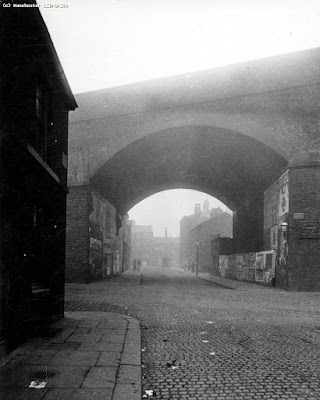To be fair Hoyle Street is still there, running from Fairfield Street down to the Ring Road.
But I think it cuts a sad appearance, and today is best known by those seeking free car parking space and the odd fan of railway viaducts, because a big chunk of it is covered by the brick viaducts that stretch out from Piccadilly Railway Station while the rest is bordered by open land and a few industrial units.
It is a place waiting for something to happen, and no doubt that something will be blocks of apartments and perhaps even in a new “office quarter”.
And that has been its fate for over 70 years.
In 1950, the entire stretch from Fairfield Street to Tipping Street was devoid of any buildings save one pub, and a couple of warehouses with the ominous word “Ruins” recorded on the section by the River Medlock.*
But it hadn’t always been so. The OS map of 1894 records a line of houses the length of Hoyle Street all the way to Tipping Street and dominated halfway down by the Britannia Brewery.
Although strictly speaking Hoyle Street ended where the Medlock crossed underneath, as the remaining part was New York Street.
Just when Hoyle Street was cut is still unclear. It is absent from Johnston’s map of 1818 but is there by 1840, when a Mr. Adam Jackson was living at no 3. He described himself as a “Teacher of Mathematics and was listed as such in Slater’s Directory for 1855.
And he rubbed shoulders with neighbours who might equally be regarded as a cut above the average.
These included, an engraver, a manager, a solicitor’s clerk, a Professor of Music and a “superintendent of police”.
But it was still a mixed community and there was also a shop keeper, warehouseman, a file cutter, mechanic and cooper.
It is difficult to work out just what the properties were like, but Mr. Jackson and some of his neighbours were paying 5s a week in rent.
At which point trying to make comparisons based on total income is fraught with difficulties, but in the 1850s a male teacher in a National School would earn a £1 a week and female teacher 6s and manual workers might bring in more or less depending on their skills and circumstance. So a textile worker in his 30s could command a wage of 22s 8d, which was much better than an agricultural labourer who might be paid between 15s to 21s a week with a few on 24s.**
Just what the 5s a week brought is also difficult to work out. Only a few of the properties on Hoyle Street had survived into 1911, when the census return recorded the number of rooms in each house.
Most of those left consisted of 5 rooms, but some were only three.
Sadly Mr. Jackson’s house is not one of those that made it onto the 1911 census and that I think must be because it was swept away by an extension to the railway viaduct in 1905.
Leaving me just to reflect on what Mr. Jackson and his wife Margaret would have seen as they walked out of their home on a summer’s day in 1851.
Their home was in the shadow of the first railway viaduct, while opposite there was a timber yard and the Ardwick Saw Mill.
The River Medlock which flowed just a few feet away was still open to the sky, and supplied water for the Britannia Brewery and a host of factories close by which included two dye works and the Mayfield Print Works.
Of course, we will never know just what they thought of where they lived, but I am guessing it was a world away from the rural Cumberland where they had both grown up.
The incessant noise from the factories, the regular sound of railway trains passing close by, and the pervading smells from the river and various dyeworks were something I doubt they ever really came to terms with.
But that is so much historical speculation and tosh and seems a good point to close.
Pictures; Hoyle Street Bridge, 1898, H. Entwhistle, m66779, m66778, courtesy of Manchester Libraries, Information and Archives, Manchester City Council, http://images.manchester.gov.uk/index.php?session=pass Hoyle Street in 1851, from Adshead map of Manchester 1851, courtesy of Digital Archives Association, http://digitalarchives.co.uk/ Temperance Street, Hoyle Street Junction looking towards Ardwick Station; and the River Medlock, 2020 from the collection of John Anthony Hewitt
*The Corporation Inn
**Textile workers, Frow, Edmund & Ruth, Radical Salford, Neil Richardson, Swinton,1984 page 34, and agricultural labourers, Agricultural Labourers’ Earnings, Parliamentary Papers 1861






No comments:
Post a Comment